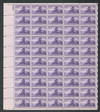
1947 3c Utah Centennial
# 950 - 1947 3c Utah Centennial
$0.35 - $27.50
U.S. #950
3¢ Utah Centennial
3¢ Utah Centennial
Issue Date: July 24, 1947
City: Salt Lake City, UT
Quantity: 131,968,000
Printed by: Bureau of Engraving and Printing
Printing Method: Rotary Press
Perforations: 11 x 10 1/2
Color: Dark violet
City: Salt Lake City, UT
Quantity: 131,968,000
Printed by: Bureau of Engraving and Printing
Printing Method: Rotary Press
Perforations: 11 x 10 1/2
Color: Dark violet
U.S. #950 commemorates Utahs 100th anniversary of settlement. The stamp pictures the first settlers entering the Great Salt Lake valley and the words "This is the Place", which Brigham Young said when he led early pioneers on their trip to Utah.
Settling Utah
The first Americans believed to have reached Utah were members of a fur-trading party. They crossed present-day northern Utah in 1811-12. Famous frontiersman and scout Jim Bridger is thought to be the first white person to see the Great Salt Lake. Bridger tasted the salty water in the winter of 1824-25, and believed he had discovered an ocean. Soon, more trappers and traders came to Utah. A trail connecting Santa Fe, New Mexico, and Los Angeles, California, brought many travelers through the area.
The Mormons belonged to the Church of Jesus Christ of Latter-Day Saints, founded by Joseph Smith in Fayette, New York, in 1830. Smith died in 1844, and Brigham Young became the church's leader. The Mormons were persecuted because of their beliefs. As a result, they moved around the U.S., looking for a place to settle. After moving from Ohio, Missouri, and Illinois, Young led the Mormons west. In 1847, they reached the Great Salt Lake. The Mormons settled the area.
In 1849, the Mormons established the Perpetual Emigrating Fund. This fund helped Mormons move to Utah. It operated for about 40 years and attracted about 50,000 Mormons to Utah. These people came from other areas of the United States as well as Denmark, England, Norway, Scotland, Sweden, and Wales.
U.S. #950
3¢ Utah Centennial
3¢ Utah Centennial
Issue Date: July 24, 1947
City: Salt Lake City, UT
Quantity: 131,968,000
Printed by: Bureau of Engraving and Printing
Printing Method: Rotary Press
Perforations: 11 x 10 1/2
Color: Dark violet
City: Salt Lake City, UT
Quantity: 131,968,000
Printed by: Bureau of Engraving and Printing
Printing Method: Rotary Press
Perforations: 11 x 10 1/2
Color: Dark violet
U.S. #950 commemorates Utahs 100th anniversary of settlement. The stamp pictures the first settlers entering the Great Salt Lake valley and the words "This is the Place", which Brigham Young said when he led early pioneers on their trip to Utah.
Settling Utah
The first Americans believed to have reached Utah were members of a fur-trading party. They crossed present-day northern Utah in 1811-12. Famous frontiersman and scout Jim Bridger is thought to be the first white person to see the Great Salt Lake. Bridger tasted the salty water in the winter of 1824-25, and believed he had discovered an ocean. Soon, more trappers and traders came to Utah. A trail connecting Santa Fe, New Mexico, and Los Angeles, California, brought many travelers through the area.
The Mormons belonged to the Church of Jesus Christ of Latter-Day Saints, founded by Joseph Smith in Fayette, New York, in 1830. Smith died in 1844, and Brigham Young became the church's leader. The Mormons were persecuted because of their beliefs. As a result, they moved around the U.S., looking for a place to settle. After moving from Ohio, Missouri, and Illinois, Young led the Mormons west. In 1847, they reached the Great Salt Lake. The Mormons settled the area.
In 1849, the Mormons established the Perpetual Emigrating Fund. This fund helped Mormons move to Utah. It operated for about 40 years and attracted about 50,000 Mormons to Utah. These people came from other areas of the United States as well as Denmark, England, Norway, Scotland, Sweden, and Wales.









